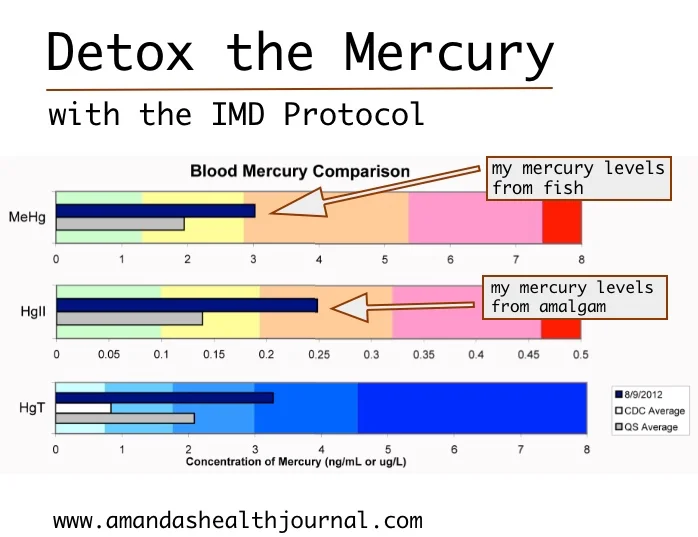The other night I came across Jenna Smith's excellent Lyme site, which unfortunately is no longer available. In this post, Chronic Lyme Disease of Mercury Poisoning?, she writes about how impossible it is to figure out whether your symptoms are due to mercury or Lyme or some other infection, since the overlap is quite large. I related so much to this article because as I've written many times, whenever I went after bad bacteria and other parasites, I'd get symptoms of die-off - at least that's what the doctor would say, or the websites I read would say - but to me it felt like mercury mobilization. And I was only able to 'know' that after years of experience trying things like grapefruit seed extract, or NDF, or DMSA or alpha lipoic acid...
One notable mercury mobilization symptom for me was (and I say 'was' because I've not had it for a long time, even though I've been actively chelating mercury for a few months now with a new protocol - this is good): depression. Depression that would last only a day or two, but was pretty debilitating. Like go into the bedroom for hours and not come out type debilitating.
For years I went after the bad bacteria, or the yeast - off and on, off and on, not achieving anything except die-off and Hg mobilization symptoms. A tail-spin.
Likewise, for years I tried chelating: NDF, Modifilan, DMSA and ALA, and not getting anywhere. In fact, last summer when I did Andy Cutler's protocol, where you take small amounts of DMSA and/or ALA every few hours for 3 days on and 4 days off, I got worse. New symptoms arose. The big one was all-over body stiffness. And also a strange shift in my jaw that seemed to happen overnight one night, during an alpha lipoic acid round. My right teeth touch and my left side does not. My bite was not good before, now it really is a mess! Still can't explain what happened with that one. But I'm sure it will right itself out soon.
As Jenna writes below, it's possible that mercury-toxic people who also have Lyme suffer less Lyme symptoms because the mercury is suppressing immunity and the natural response to inflammation - pain - is less. I feel like this is what happened to me last summer. I did 45 or so DMSA and ALA rounds, only to find that my body became very stiff and inflexible and painful. I was like a 90 year old woman, taking several minutes to get up off the floor. That's when I knew chelation wasn't getting me better. It was making me worse. Thankfully I turned my focus back to the possibility of infection. My hair was also falling out a lot and I learned that that too could be caused by infection.
Here's the big picture for me, and people like Jenna and Dr. Klinghardt and others have beat me to it: kill the infections while you mobilize and excrete the mercury. And detox detox detox as you do it. Don't go too fast. Be steady and steadfast. I believe this is the ticket.
Here's Jenna:
Because the Lyme Disease bacteria and mercury typically occupy the same places in the body, the symptoms of each are very difficult to distinguish. Someone with Lyme Disease may not be aware that they have mercury poisoning and thus assume that all of their symptoms are Lyme Disease-related, when in reality, some are mercury symptoms.
A person who knows they have both mercury toxicity and Lyme Disease finds that the next challenge is to separate the symptoms and determine which are caused by which problem.
The presence of mercury in the living environment of the bacteria is advantageous to the bacteria. As the mercury-rich environment is altered, the infection responds with self-protective activities.
To make matters even more complicated, when Lyme Disease organisms are being killed or attacked, mercury symptoms may be altered as well.
As you manipulate the Lyme bacteria’s living environment and kill Lyme Disease organisms, mercury is mobilized and released which can cause symptoms to flare up unbearably.
Sometimes mercury is actually stored inside a spirochete or bacterial colony itself. When that colony is disrupted or eradicated (with antibiotics or rife machines or some other anti-Lyme treatment), mercury is released. This results in an outbreak of both herx reaction symptoms and mercury mobilization symptoms.
In fact, many herx symptoms commonly experienced by Lyme Disease sufferers are actually symptoms of mercury mobilization. Because dying Lyme Disease organisms can release mercury, it is important to use a mercury detoxification protocol while undertaking anti-Lyme therapy to sop up the mercury that is released during the killing of Lyme Disease bacteria.
Mercury is a very strong immunosuppressant, and its presence in the body may mask inflammatory Lyme Disease symptoms. Lyme Disease patients may actually feel that their Lyme Disease symptoms are better when they are mercury-poisoned because the inflammatory response to Lyme Disease is reduced. When mercury is removed from the body, an individual may experience increased Lyme Disease symptoms and herx reactions because the immune system may begin to function properly again.
Another confusing similarity is that mercury chelators are not able to reach mercury stored inside Lyme Disease organisms until the organisms are killed and the mercury is released into circulation. Therefore, as long as there continues to be an active Lyme Disease infection, it is also likely that additional mercury is sequestered throughout the body. For this reason, mercury detoxification should not be considered to be finished until all Lyme Disease bacteria are completely eradicated. A mercury removal program is often needed for quite a long time, sometimes even years.




